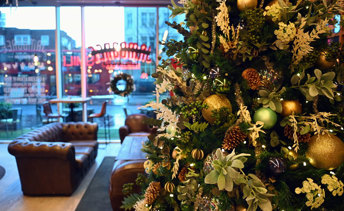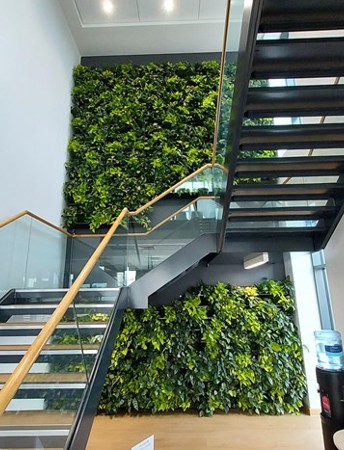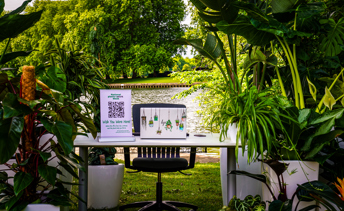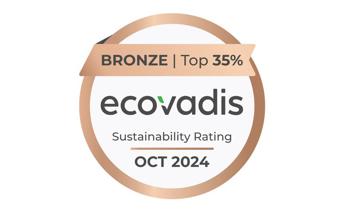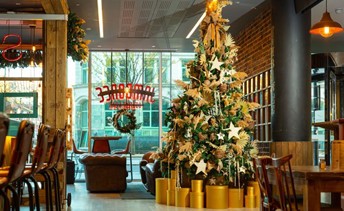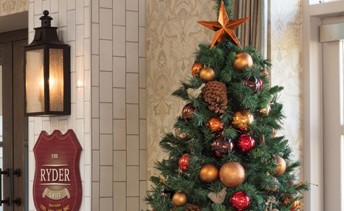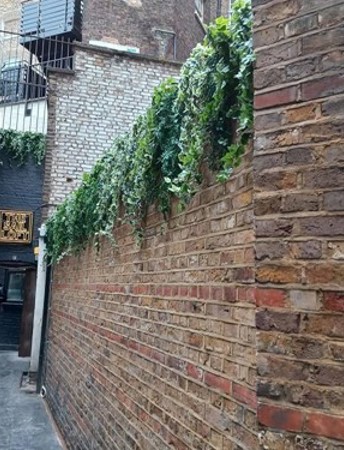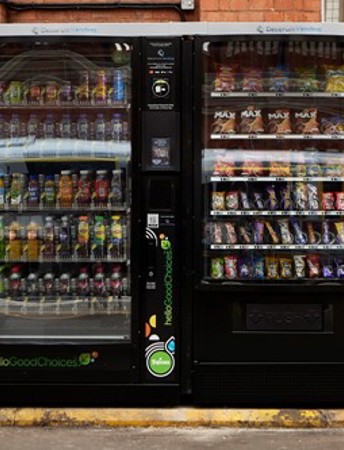Hardscaping is a critical aspect of commercial landscape design, often serving as the backbone that shapes the functionality, aesthetics, and durability of outdoor spaces.
While softscaping, which includes plants, trees, and grass, is essential for adding life and colour, hardscaping elements like walkways, patios, retaining walls, and water features provide structure and form. Together, they create a balanced and cohesive environment that not only enhances the beauty of a commercial property but also improves its usability, safety, and value.
As the UK’s leading provider of commercial gardening and landscaping services, we have decades of experience designing and improving hardscaping areas.
Join us as we go more in depth with hardscaping in commercial landscaping - but first, a little more on what this means:
What is Hardscaping?
Hardscaping refers to the non-living elements of a landscape design. These elements include anything from paved walkways, stone patios, and concrete driveways to wooden decks, pergolas, and decorative stonework. Hardscaping is responsible for creating the "bones" of a landscape, providing structure and definition to the space. Unlike plants, which require ongoing care and maintenance, hardscaping is typically a one-time installation that can last for decades with minimal upkeep.
How does Hardscaping Help Enhance Functionality?
One of the primary roles of hardscaping in commercial landscape design is to enhance the functionality of outdoor spaces. For commercial properties, this is particularly important as the landscape often needs to accommodate a variety of users, from employees and customers to delivery vehicles and maintenance crews.
For example:
Walkways and Pathways: Well-designed walkways guide foot traffic through the property, ensuring safe and easy access to entrances, exits, and key areas. By strategically placing pathways, businesses can control the flow of people and minimise damage to the softscape areas, such as lawns and flower beds.
Patios and Seating Areas: Patios and seating areas provide spaces for employees and visitors to relax, socialise, or even work outdoors. For restaurants, hotels, and corporate campuses, these areas can significantly enhance the customer experience by offering comfortable, attractive outdoor environments.
Car Parks, Entry Ramps and Driveways: Hardscaping extends to functional necessities like parking areas and driveways. These areas must be designed to handle heavy traffic and provide a smooth, durable surface that complements the overall landscape design.
Retaining Walls: In properties with varying elevations, retaining walls are essential for managing soil erosion, creating level planting areas, and adding visual interest. They also serve a practical purpose by preventing landslides and making sloped areas usable.
Aesthetic Appeal and Branding
Beyond functionality, hardscaping plays a significant role in the aesthetic appeal of a commercial landscape. The materials, colours, and textures chosen for hardscaping elements can reinforce a company's brand image and create a lasting impression on visitors.
When planning your hardscaping, you will have an opportunity to make several branding related decisions, for example:
Material Choices: The choice of materials—whether it’s natural stone, brick, concrete, or wood—can convey a particular style or atmosphere. For example, sleek concrete and metal might suggest a modern, industrial aesthetic, while natural stone and wood could evoke a more rustic or traditional feel.
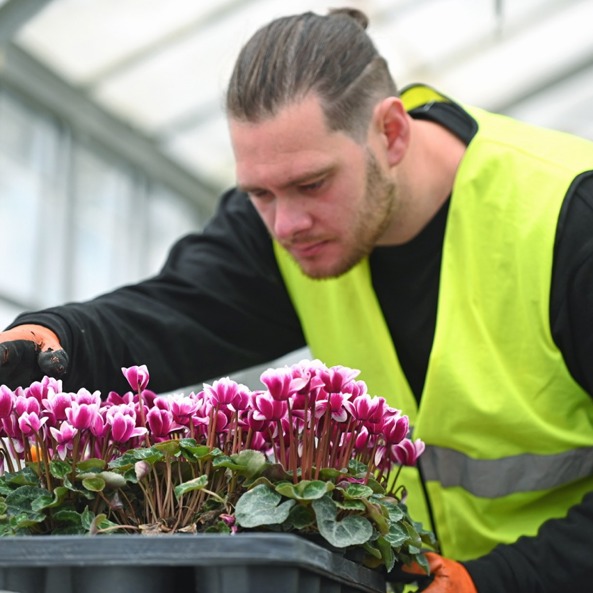
Colour and Texture: The colour and texture of hardscaping materials should complement the building's architecture and the surrounding softscape. For instance, a warm-toned brick walkway might pair beautifully with lush green lawns and colourful flower beds, creating a welcoming and harmonious environment.
Custom Features: Custom hardscaping elements, such as engraved stones, branded pavers, or decorative walls, can incorporate a company's logo or other brand elements directly into the landscape. This subtle branding enhances corporate identity and reinforces the business's presence in the community.
Hardscaping is Low Maintenance and Durable
One of the advantages of hardscaping over softscaping is its durability and low maintenance requirements. While plants need regular watering, pruning, and fertilisation, hardscape elements are generally more resilient and require less frequent attention for several reasons:
Weather Resistance: Properly installed hardscaping can withstand various weather conditions, from intense heat to freezing temperatures, without deteriorating. Materials like stone, concrete, and metal are particularly durable and can last for decades with minimal upkeep.
Pest and Weed Control: Hardscaping elements can help reduce the spread of pests and weeds by providing barriers that are difficult for them to penetrate. For example, a well-laid stone patio is less likely to become overgrown with weeds than a lawn or garden bed.
Cost-Effective Over Time: Although the initial installation of hardscaping may be costly, the long-term savings in maintenance and replacement costs make it a cost-effective solution for commercial properties. With proper care, hardscaping features can retain their appearance and functionality for many years.
Environmental Considerations
In modern landscape design, sustainability and environmental impact are increasingly important considerations. Hardscaping can contribute positively to these goals when designed thoughtfully.
Well designed and executed hardscaping can help with:
Water Conservation: Hardscaping can reduce the need for irrigation by minimising the amount of softscape that requires regular watering. Additionally, permeable paving materials allow rainwater to seep through the ground, reducing runoff and promoting groundwater recharge.
Erosion Control: Retaining walls and other hardscaping elements can prevent soil erosion, particularly on sloped properties. This not only protects the landscape but also helps maintain the integrity of nearby waterways and ecosystems.
Sustainable Materials: The choice of materials can also impact the environment. Recycled or locally sourced materials reduce the carbon footprint associated with transportation and manufacturing. Using sustainable materials also aligns with many businesses' goals to operate more eco-consciously.
Safety and Accessibility Concerns
Hardscaping plays a crucial role in ensuring that commercial landscapes are safe and accessible for all users. A few considerations that can help improve safety and accessibility in your commercial premises include:
Lighting: Incorporating lighting into hardscaping elements, such as along pathways or in seating areas, improves visibility and safety, especially at night. This is particularly important for businesses that operate during evening hours or have 24-hour access.
Slip-Resistant Surfaces: Choosing slip-resistant materials for walkways, stairs, and patios is essential to prevent accidents, especially in areas prone to rain or ice. Textured surfaces or non-slip coatings can provide additional safety.
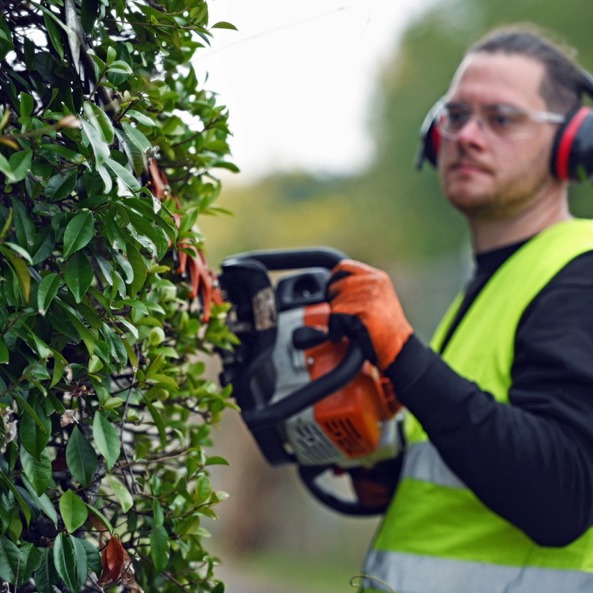
Integration with Softscaping
While hardscaping provides structure, it can’t be the only type of landscaping used. Softscaping adds life and colour to a commercial landscape. The best landscape designs seamlessly integrate the two, creating a balanced and cohesive environment.
A few of the most effective ways to integrate softscaping and hardscaping are listed below:
Planting Beds: Hardscape elements like stone borders or retaining walls can be used to define planting beds, adding both visual interest and practical separation between different types of vegetation.
Water Features: Incorporating water features such as fountains, ponds, or waterfalls can soften the appearance of hardscape elements and create a tranquil atmosphere. These features also provide opportunities to incorporate aquatic plants or even attract wildlife.
Shade and Shelter: Hardscaping structures like pergolas, gazebos, and awnings provide shade and shelter, making outdoor spaces more comfortable and usable. These structures can also support climbing plants, adding a touch of greenery and blending the hard and soft elements.
Planning and Executing Hardscaped Elements
Successful hardscaping requires careful planning and execution. It’s important to work with experienced landscape designers and contractors such as phs Greenleaf, as it’s crucial to have the project planned and implemented by someone who understands the specific needs of commercial properties.
Initial steps are likely to include:
Site Assessment: A thorough site assessment is the first step in any hardscaping project. This includes evaluating the soil, drainage patterns, existing vegetation, and overall layout of the property.
Design Considerations: The design process should consider both the functional and aesthetic goals of the project. This includes selecting appropriate materials, designing for traffic flow, and ensuring that the hardscape complements the softscape.
Permits and Regulations: Depending on the scope of the project, local permits and regulations may need to be considered. Working with a national provider who is familiar with these requirements such as phs Greenleaf can help avoid potential delays or legal issues.
Quality Installation: The installation process is critical to the success of the hardscaping. Proper techniques must be used to ensure the longevity and durability of the materials, particularly in areas with extreme weather conditions.
Hardscaping is an integral part of commercial landscape design, offering both functional and aesthetic benefits. By providing structure, enhancing usability, and contributing to the overall appeal of a property, hardscaping helps create outdoor spaces that are not only beautiful but also practical and sustainable. For businesses looking to make a lasting impression, investing in quality hardscaping is a wise decision that will pay dividends for years to come.
Click here to learn about our industry leading gardening and landscaping services, or contact us now to discuss your own unique requirements.



























